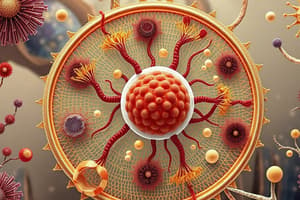Podcast
Questions and Answers
Which organelle is primarily involved in protein synthesis in a cell?
Which organelle is primarily involved in protein synthesis in a cell?
- Mitochondria
- Endoplasmic Reticulum (correct)
- Nucleus
- Cytoplasm
What is the main function of smooth endoplasmic reticulum in a cell?
What is the main function of smooth endoplasmic reticulum in a cell?
- Lipid synthesis (correct)
- Protein synthesis
- Energy production
- Cell death regulation
Which organelle is often referred to as the 'powerhouse of the cell'?
Which organelle is often referred to as the 'powerhouse of the cell'?
- Cytoplasm
- Mitochondria (correct)
- Endoplasmic Reticulum
- Nucleus
What is the primary function of the mitochondrial inner membrane?
What is the primary function of the mitochondrial inner membrane?
Which cellular component provides a medium for cellular activities such as protein synthesis and energy production?
Which cellular component provides a medium for cellular activities such as protein synthesis and energy production?
What is the primary role of the nucleus in a cell?
What is the primary role of the nucleus in a cell?
What is the primary function of the cell membrane?
What is the primary function of the cell membrane?
Which structure within the nucleus is responsible for ribosome production?
Which structure within the nucleus is responsible for ribosome production?
What is the main function of the endoplasmic reticulum in a cell?
What is the main function of the endoplasmic reticulum in a cell?
Which organelle is responsible for housing the genetic material of a cell in a protected environment?
Which organelle is responsible for housing the genetic material of a cell in a protected environment?
Which cell structure is involved in energy production and often referred to as the 'powerhouse' of the cell?
Which cell structure is involved in energy production and often referred to as the 'powerhouse' of the cell?
In which part of the cell does protein synthesis primarily occur?
In which part of the cell does protein synthesis primarily occur?
Flashcards are hidden until you start studying
Study Notes
Cell Structures: Exploring the Components of Life
At the heart of all living organisms are cells, which are the smallest units capable of independent life. These cells contain specialized structures, each with a unique role in maintaining cellular function. Let's delve into the primary cell structures, examining their functions and significance.
Cell Membrane
The cell membrane, also known as the plasma membrane, is a selectively permeable barrier that surrounds the cell. It consists of a lipid bilayer with embedded proteins that provide structural support and facilitate communication between the cell and its environment. The membrane selectively allows certain molecules to pass through, while keeping others out, ensuring the cell's integrity and proper function.
Nucleus
The nucleus is the cell's control center, housing the cell's genetic material, or DNA. DNA molecules are packaged into structures called chromosomes, which are then enclosed within a protective membrane called the nuclear envelope. The nucleus coordinates cellular activities by producing RNA molecules, which are then used to synthesize proteins. The nucleolus, a dense structure within the nucleus, is responsible for ribosome production.
Endoplasmic Reticulum
The endoplasmic reticulum (ER) is a network of membrane-bound tubules and sacs that function in protein synthesis and lipid production. There are two types of ER: rough ER, which is studded with ribosomes involved in protein synthesis, and smooth ER, which is responsible for lipid synthesis, detoxification, and the production of steroid hormones. The ER assists in the folding and transport of proteins to their final destinations.
Mitochondria
Mitochondria are often referred to as the "powerhouses of the cell," as they are the primary site of cellular respiration and energy production through oxidative phosphorylation and the production of adenosine triphosphate (ATP). Mitochondria also play a role in the cell's response to stress and the regulation of cell death. The mitochondrial outer membrane is permeable, while the inner membrane is highly selective, allowing for the transport of specific molecules across the membrane.
Cytoplasm
The cytoplasm is the gel-like, semifluid substance that fills the space between the cell membrane and the nucleus. It contains various cellular organelles, as well as soluble molecules such as enzymes, nutrients, and waste products. The cytoplasm provides a medium for cellular activities, such as protein synthesis and the production of energy.
In summary, cells contain a variety of specialized structures that enable them to carry out their unique functions. Understanding these structures and their roles is crucial to understanding the living world. The cell membrane, nucleus, endoplasmic reticulum, mitochondria, and cytoplasm all contribute to the complexity and efficiency of life at the cellular level.
Studying That Suits You
Use AI to generate personalized quizzes and flashcards to suit your learning preferences.




